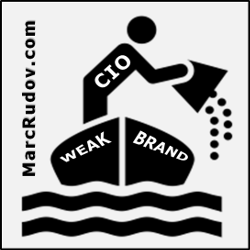 The CIO, or chief information officer, builds, grows, and maintains an enterprise’s IT (information technology) infrastructure.
The CIO, or chief information officer, builds, grows, and maintains an enterprise’s IT (information technology) infrastructure.
This web of pipes and access points serves employees, customers, investors, channels, and reporters — and must do so reliably, 24×7.
In our age of rapid innovation (often needless) and obsolescence — and constant malicious hacking (remember when the North Koreans hacked Sony Pictures?) — the CIO’s job is tenuous, with an average tenure of 4.3 years.
Despite what the trade publications advocate, real success in the CIO job hinges on wisely leveraging technology to keep the company’s brand strong.
Vomiting of New Technology
How does the CIO know what to build?
The brand — which determines the company’s purpose and direction — provides the answer.
Any IT implementation must be tied to the brand, depicted in the figure below, incorporating an objective assessment of internal and external needs, over a reasonable time horizon.
Violate this axiom at your peril.
Three categories of IT implementation can sink a CIO:
|
The third category is more pervasive than one might believe. A lot of IT impetus across the landscape derives from “industry trends” and the neverending vomiting of new technology, whether necessary or not.
Today, most firms are forcing AI, or artificial intelligence, into every conceivable product and process, even if doing so degrades service and alienates customers (hurts the brand).
You doubt me? Call customer support at any large corporation, from AT&T to Apple; you’ll get an ulcer. Tune into CNBC and Fox Business Network: all you’ll hear from the talking heads is that technology will save the world, and that we must be smothered in it.
Au contraire! Technology is making people stupid and lazy, and engendering depression and loneliness. Blame unsocial media. So, more is not better.
|
The Overautomated Car Allow me to share a revealing experience I had communicating with a major, internationally known semiconductor company. On its website, said firm brags that it can address the burgeoning opportunity to build electronic sensors and controls on the computer-on-wheels also known as the automobile. On the diagram provided, every square inch of the rapidly evolving car contains a chip. What else would one expect? All I could picture, while ruminating about the computerless ’57 Chevy, is a local dealer’s service department making a fortune from fixing each inevitably failing car. I asked this company’s head of marketing to consider the practical limit of his overautomated car — the point at which customers will reject this one-ton electronic burden as unreliable and undesirable. And, when that happens, I averred, his model will collapse. NOTE: This is the antithesis of how high-tech companies think. How dare I ask such an impertinent, technologically incorrect question! Technologism, the religion of technology, posits that, if something is technically doable, it shall be done and must be done. His response dumbfounded me. First, he admitted being unable to address my valid question. Second, he expressed frustration about typical societal lethargy — you know, people slowly “arriving” to accept technology. Nothing about customers’ wants, needs, demands, and budgets. He blamed them for their sluggish rate of adoption. Can you spell Edsel? NEWSFLASH: Technology is a means to an end, not the end. Technology, like government, serves us, we don’t serve it. Alas, many technocrats like the idea of technology controlling, monitoring, and replacing humans. In fact, that love of tyranny, not the bogus “safety” argument, is what’s driving the autonomous car. Watch my video about this dangerous product. |
Lessons for the CIO
Learn from the overautomated-car vignette above. Don’t take your enterprise down a financial rat-hole to impress your industry colleagues at seminars and on TV.
Make technology serve employees, customers, investors, channels, and reporters — not the other way around.
Information technology (IT) must bolster your company’s brand, not dilute or harm it.
Insist that your company create and maintain a strong brand: the only way to increase the number and loyalty of customers, and the basis for building an IT infrastructure.
Finally, a weak brand will beget an ill-suited IT infrastructure, which will sink you.
© 2018 Marc H. Rudov. All Rights Reserved.
About the Author

Marc Rudov is a branding advisor to CEOs,
producer of MarcRudovTV, and author of four books


